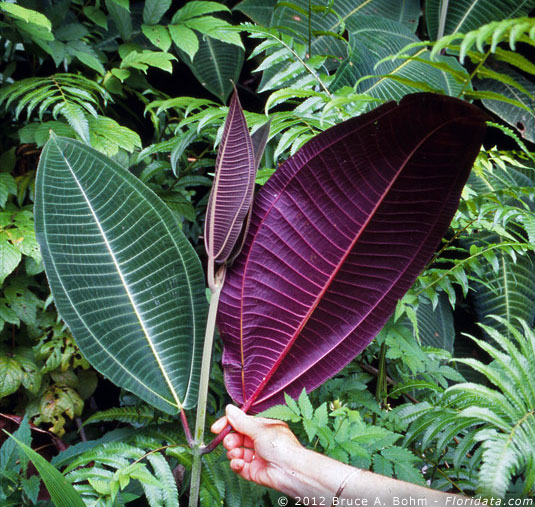
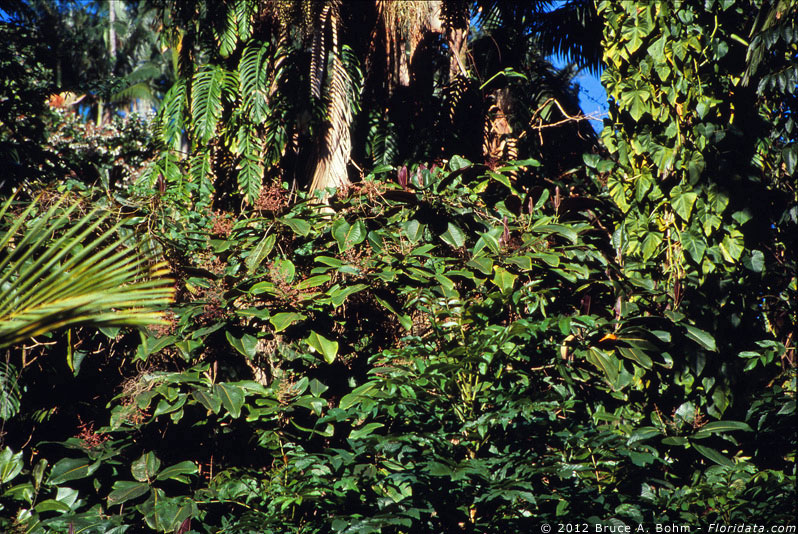


It has been suggested that the entire native Hawaiian flora could be destroyed in a few generations by a combination of about a half dozen of the most aggressive alien species that have become established on the islands. It would be an interesting exercise to ask several experts to list their candidates for the five worst aliens and then compare the lists. An examination of Alan Ziegler's list, in his 2002 book Hawaiian Natural History, Ecology, and Evolution, shows most of the following examples; all five of my selections are included in his list. One certainly on all of the lists would be, depending on your choice of name, "green cancer," "purple plague," or, botanically, Miconia calvescens. It is often referred to simply as miconia. A single individual of this species was introduced into a botanical garden in Tahiti in 1937. Today, it has become the dominant plant in nearly 70% of disturbed habitats forcing a large number of Tahitian endemic species to the brink of extinction. Could this happen in the Hawaiian Islands? This part is devoted to acquainting the reader with many of the alien species that wreak havoc on the local, indigenous biota. Owing to the seriousness of the miconia problem, it gets star billing. But when we look at the family itself we see that it is not just the one species that presents a problem.
The family is a moderately large one with 5,150 species sorted into 179 genera according to Mabberley (p. 534), or 4,500 and 200, respectively, following authors of the Manual. Members of the family occur widely in warm and tropical regions with the richest diversity in South America. Eleven genera with a total of 14 species can be found on the Hawaiian Islands. The majority do not appear to present any major problems. The exceptions, however, are the reason for the dire introduction. We will begin with the worst, green cancer itself, Miconia calvescens.
In most situations where people must deal with potentially invasive species they have to start essentially from ground zero making decisions on the fly; without some background information on a particular plant it is not always possible to make the wisest decision. But when information is available it should be used. This was not the case with miconia in the Hawaiian Islands; a good deal was known about the plant's potential for disaster from experience gained on Tahiti. In 1996 two French workers, Jean-Yves Meyer and Jacques Florence, described the miconia situation in French Polynesia voicing both a warning and a cry for help. Their involvement, and a comprehensive summary of the miconia problem, prepared by Lloyd Loope, Station Leader, Pacific Islands Ecosystems Research (PIER) Center, Haleakalä, can be found at the following address: www.hear.org/miconiainhawaii/miconiasummarybylll.htm . The story is quite simple. In 1937 a single plant of M. calvescens , a native of the Americas from Mexico to South America, was planted in the Papeari Botanical Garden in Tahiti as an ornamental. It was also planted on the plateau of Taravao (Tahiti-Iti); time passed with miconia attracting no special attention. The situation changed dramatically when in the early 1970s botanists noticed that miconia had begun to form pure stands on the plateau. It has now spread to all mesic and wetland habitats between 10 and 1,300 m, covering over two-thirds of Tahiti, amounting to an area of at least 173,000 acres (ca. 70,000 ha). Miconia has spread beyond the confines of the main island, however; it now occupies considerable acreage on the islands of Moorea, Raiatea, and Tahaa.
Appearance of miconia in the Hawaiian Islands occurred more recently, but the subsequent spread of the plant parallels that of Tahiti. The tree was brought into the islands in the late 1950s as a commercial decorative plant and as an acquisition by botanical gardens. Its very large leaves with their attractive coloration (see images) made it appealing to buyers wishing to include a fast-growing shade plant in their gardens. Its escape from cultivation and rapid spread brought it to the attention of officials by the early 1990s resulting in its listing as a noxious weed in the state in 1992 (but not in the national register, at least at that time). By the time officials had begun to pay serious attention to this intruder, however, it had already spread significantly.
Miconia grows rapidly reaching heights of 25' (8 m) when mature, but flowering and fruiting can occur when the trees are only 10-13' (4-5 m) tall and between four and five years old. Mature trees can flower three times per year and can produce 50-200 inflorescences during each flowering cycle, depending upon the level of sunlight. Each inflorescence can have 1,000-3,000 flowers (and thus fruits), and each individual fruit can have 50-200 seeds. Taking average numbers, we can do some simple arithmetic: 100 inflorescences x 300 fruits per inflorescence x 100 seeds per fruit = 3 million seeds; and this can happen three times a year! Not all of these seeds germinate each year, of course, but they do tend to stay in the soil for some time, at least four years. An experiment in Tahiti revealed the potential that lies in the seed bank: soil was taken from a depth of 2 cm (3/4 inch) from a meter square plot, watered, and monitored over time. With periodic disturbance, 17,808 seedlings appeared over a period of six months. Thus, any plot that is cleared of miconia trees must be monitored on a regular basis so that the next set of seedlings can be destroyed. Other observations revealed that germination rates in the order of 90% are normal and that seedlings appear in 15-20 days. With this prodigious level of fruiting and the availability of efficient dispersers, especially the alien bird species Japanese White-eye (Zosterops japonicus), among others, is it any wonder that this plant has had such success?
Once located, plants can be pulled out of the ground, if they are small enough, or cut off, but in the latter case treatment of the cut stump with an herbicide is necessary to prevent re-sprouting. A recently described technique for ground control that allows workers to get at individual plants and deliver lethal doses of herbicide involves 'herbicide ballistic technology,' HBT for short. Developed by Dr. James Leary, a weed specialist at the University of Hawai`i-College of Tropical Agriculture and Human Resources, HBT allows very small doses of chemicals–imazapyr and others–with a high degree of accuracy using recreational paint-guns. Application of powerful non-specific herbicides requires accurate targeting of weedy plants, a requirement apparently met by this application procedure. Trials using a helicopter were also successful. Readers interested in seeing a video of Dr. Leary's demonstrations, including the aerial 'gun-ship' should refer to: www.ctahr.hawaii.edu/LearyJ/videos/HBTvideos_miconia.html. Other plant pests that were successfully targeted were the Australian tree fern Sphaeropteris cooperi, Kahili ginger (Hedychium gardnerianum), and banana poka (Passiflora mollissima). More on Kahili ginger and banana poka later in this series.
Large scale ground level exploration is very difficult owing to the extremely rough mountainous terrain in much of the islands. However, aerial surveys using remote sensing techniques have been developed to provide detailed information on the location and extent of colonies in otherwise inaccessible areas. This approach is based upon the unique optical properties–the absorption and reflection of characteristic wavelengths of light–of different species of plants. The equipment can easily be accommodated by light aircraft. For details on specific aspects of this approach interested readers can visit the Carnegie Airborne Observatory site (Stanford University) at https://cao.stanford.edu/ and the site for Resource Mapping at https://resourcemappinggis.com/. Both sites provide stunning photographs and videos of typical applications of the technology.
Once infestations of miconia have been mapped, decisions have to be made as to what course of action is appropriate. In the case of monotypic stands, aerial spraying of herbicides is an acceptable approach, but in the case of scattered trees, total elimination is not possible, especially considering the capacity of these organisms to produce large seed crops. In effect, every individual tree would have to be eliminated and the area re-examined regularly to eliminate new generations of seedlings. The extent of the problem led conservationists to ask the question as to whether removal or containment would be the more feasible approach. Feasibility is, of course, a function of expense.
The costs of invasive species has been approached from a theoretical perspective by several workers. Factors considered in the models studied include the impact of invasive species on aquifer recharge, on decreased biodiversity with subsequent impact on ecotourism, and other economic issues such as impact on property values. In the case of miconia, the model predicts that population reduction is the optimal management approach for forests on O`ahu, Maui, and the Big Island, whereas on Kaua`i, where search costs are much higher owing to more difficult terrain, optimal policy suggests removal activities be deferred until the populations are large enough to warrant the expense. Economic modeling is a difficult subject for the uninitiated, of which I am one. Readers interested in pursuing this line of investigation should consult reports by Kimberley Burnett and coworkers (Burnett, 2006; Burnett et al., 2006) and visit the following address: https://www2.hawaii.edu/%7Ekburnett/JFE.pdf.
Miconia calvescens was not listed as a naturalized species by the authors of the Manual, but the seriousness of the situation was ultimately recognized in the Addendum. The genus is a large one, about 1,000 species in tropical America with a single representative in West Africa. An interesting situation exists in Trinidad where the 20 species of Miconia set fruit complementarily thus providing the potential for an unbroken proliferation of the group.
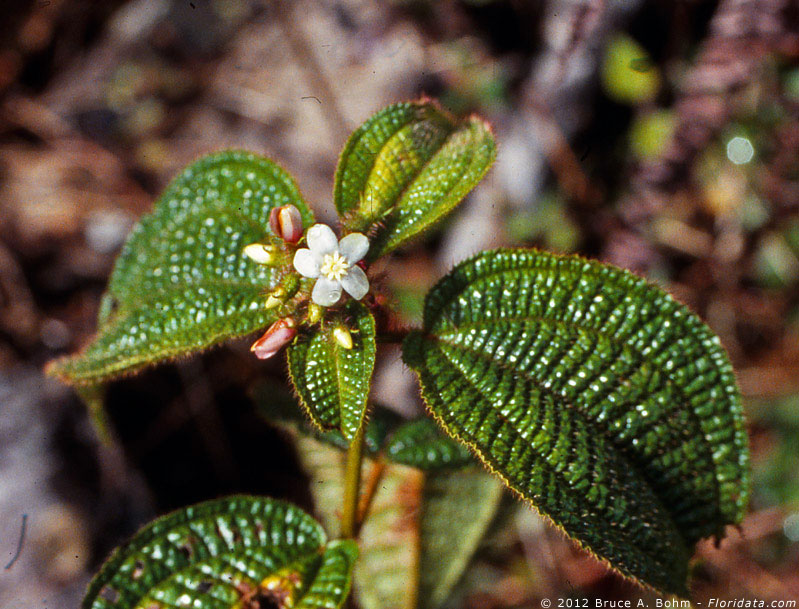
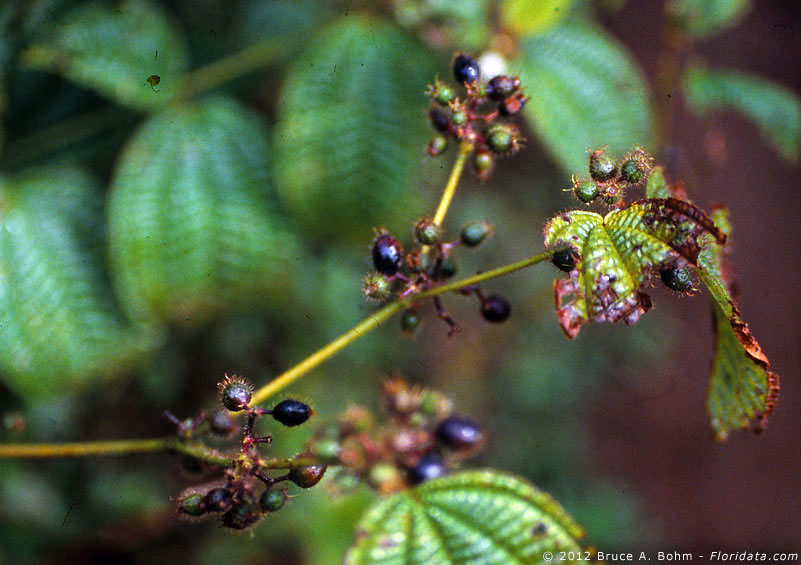
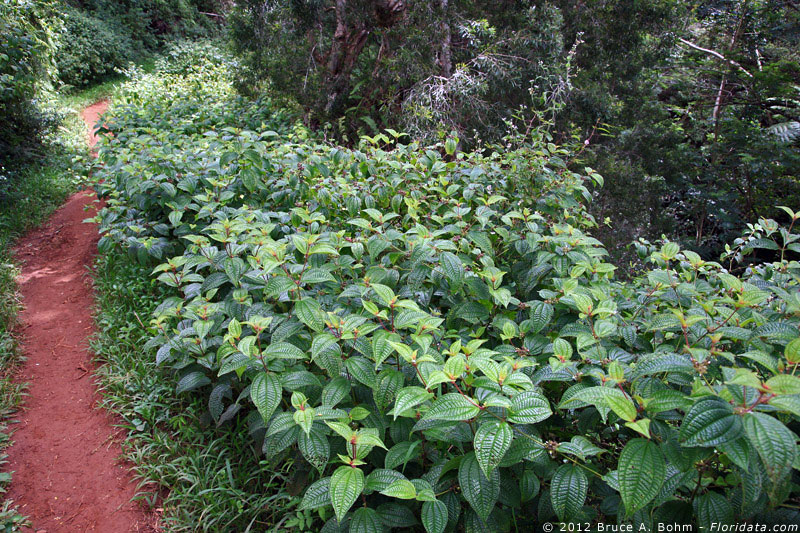
Clidemia, another neo-tropical genus well established in the Hawaiian Islands, consists of 117 species according to Mabberley (p. 195), or about 170 according to the authors of the Manual. The genus is represented in the islands by a single species, C. hirta var. hirta, known simply as clidemia, or as soap bush, camasey, camesey peludo, and other names depending upon where it has become established. Another common name is Koster's curse, although there seems to be some confusion as to who Koster was. Some consider this plant to be an even worse problem than miconia. It occurs widely on the islands quickly colonizing disturbed sites and spreading rapidly. It can easily be identified by its small white flowers (see image) and black fruits (see image), often on the same plant.
Clidemia was first detected in the Hawaiian Islands (on O`ahu) in the early 1940s (but not properly documented until 1949) and has become very widely distributed. I have seen clidemia in nearly monotypic stands along several trails on Kaua`i: Power Line Trail from the south; trail to Hanakäpï`ai Beach; and along the Kuilau Trail (see image); and on Maui along the Waihe`e Crest Trail (Boy Scout Trail). It has become naturalized in American Samoa, as well as other islands in the Pacific Basin and Indian Ocean; Australia; southern Asia; Sri Lanka; and areas in East Africa. As with miconia, where information on the problem plant's aggressiveness in Tahiti was available, the Fijian Islands had experienced the invasiveness of Koster's curse (Mack and Lonsdale, 2002). This plant had become such a problem in Fiji that it had already been declared a noxious weed by 1920. The 'solution' to the problem in Fiji was to release a thrip (other common names for this insect are thunderfly, thunderbug, storm fly, and corn louse; technically it is Liothrips urichi), which apparently worked well enough on the weed in croplands, but did not halt its invasion of native forest. Seemingly unaware–but one never knows–of the failure to protect native forests in Fiji from clidemia, authorities in the Hawaiian Islands used the same solution on miconia in 1954. Needless to say, it did not work. Mack and Lonsdale concluded, after suggesting that complete eradication in the 1950s would have been possible, that at the present time eradication, in the Hawaiian Islands, "…seems exceedingly unlikely."
Clidemia has been described as the worst of the plant invaders in the Pacific Basin. It was introduced to the Hawaiian Islands, probably on O`ahu, in the early 1940s, spread to the Big Island in 1972, Moloka`i in 1973, Maui in 1976, Kaua`i in 1982, and Läna`i in 1988. These are the dates of the first reported identification of the plant; the precise date of arrival is unknown. The spread of the weed has been most impressive having been estimated to occur over some 31,000-38,000 hectares on O`ahu by the late 1970s, but more recently over an area approaching total available land, about 100,000 hectares. [Data from https://biology.usgs.gov/s+t/SNT/noframe/pi179.htm.] It is abundantly clear, both from this example and many others in the literature, that whatever removal tactic is employed (see below), repeat visits to infested sites are necessary owing to the prolific seed production by the plant and the life time of the seeds in the soil (ca. four years). The magnitude of the problem can be appreciated by looking at some numbers: a mature plant can produce at least 500 fruits per year, each of which can contain at least 100 seeds, thus giving an annual yield of seeds at about 50,000. That level of output by 20 plants–it's not uncommon to see populations that size–would be a million seeds. Growth of plants is fairly rapid with plants reaching reproductive age in 6-10 months. Seeds can be transported by birds, pigs, mongooses, and humans (the seeds are sticky and can adhere to clothing and boots). In fact, human spread seems to be the principal route of dispersal.
Physical removal is possible for single plants or for infestations limited to small areas, but difficult and prohibitively expensive for extensive areas. Mowing does not work owing to seed load in the soil and the likelihood of re-sprouting from stumps. Clidemia is sensitive to some herbicides, but there is the perpetual problem of isolating the application to avoid native species. Application of the fungus Colleotrichum gloeosporoides has met with some success in infestations in drier areas, but appears to be less effective in wetter areas. Until a consistently successful bio-control agent is found, the future of heavily infested areas is about at dim as it is with Miconia calvescens. The most critical of all steps that must be taken in areas that have not become infested is to establish surveillance programs that must be rigorously carried out. Local groups–campers, hikers, forest workers–should become familiar with the plant and report infestations to appropriate authorities.
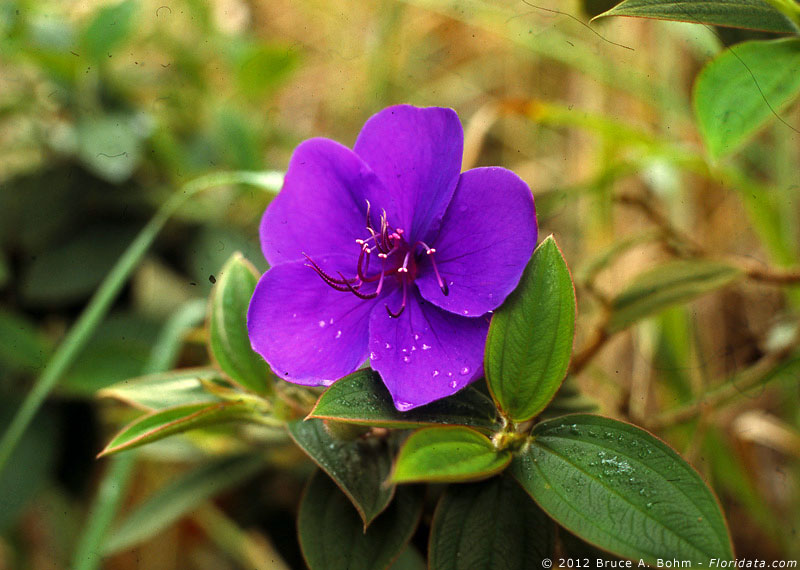
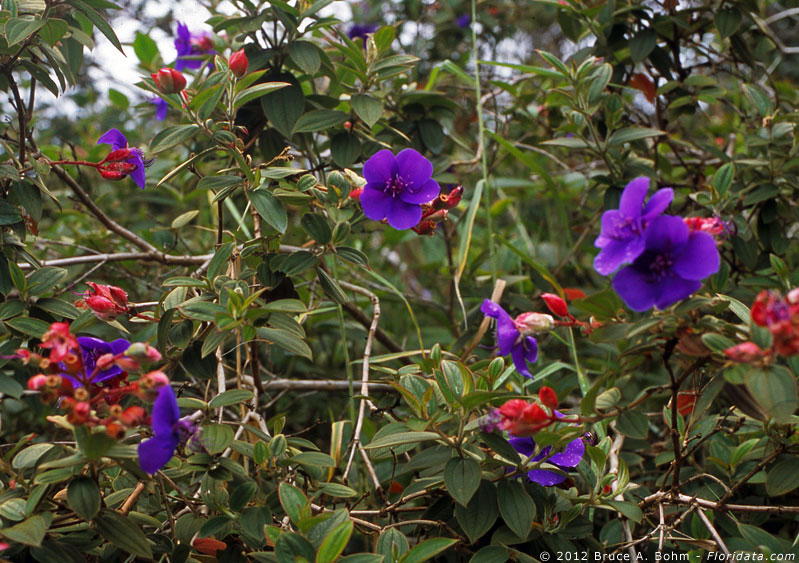
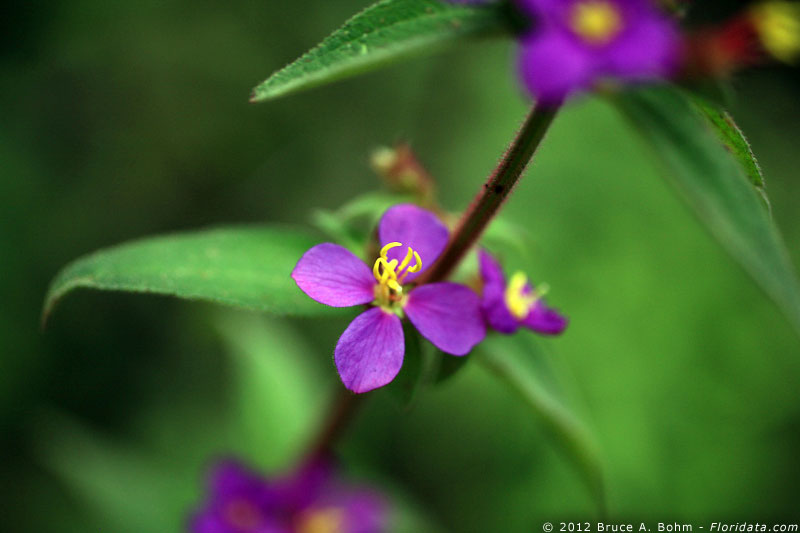
The next member of family is likely to be a lot more familiar to many readers than either of the two troublesome species above. Tibouchina is a genus of about 350 species that occurs widely in tropical America. The attractive species illustrated here (see images) is Tibouchina urvilleana, known commonly as glory bush, lasiandra (once its generic name), or princess flower.
Authors of the Manual note that this plant has been known in the horticultural trade as T. semidecandra, which is a different species not known to occur in the islands. The flower of glory bush is very attractive, although somewhat fragile (I have one in my house), but the abundance of blossoms makes it a favorite. It has escaped from cultivation in the islands and continues to spread to suitable moist habitats where it can form dense thickets. It also sprouts readily from cut stems and branches making elimination more challenging. Significant 'hedges' of glory bush can be seen along the highway heading to Hawai`i Volcanoes National Park (south west of Hilo).
Another related species of Tibouchina, T. herbacea, also occurs in the islands in disturbed sites. It is known on the Big Island, on East and West Maui, and Läna`i where the illustrated specimen (see image) was seen. A common name for this species is cane Tibouchina, owing to its straight growth habit. All species of Tibouchina have been declared noxious weeds in the state and cannot be sold or transported legally. A third species (T. longifolia) has been reported from a single individual observed along the Stainback Highway on the Big Island.
The genus Melastoma (the type genus of the family) is represented on the islands by two species, M. candidum, a native of southeastern Asia including the Philippines, Taiwan, and the Ryuku Islands, occurs in wet areas on Kaua`i and the Big Island; and M. sanguineum, also native to southeastern Asia. This species occurs on the Big Island along the highway between Hilo and Volcano. The pale pink flowers (see image) and habit (see image) are illustrated here.
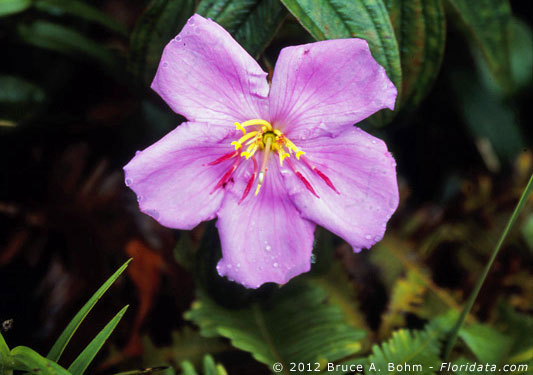
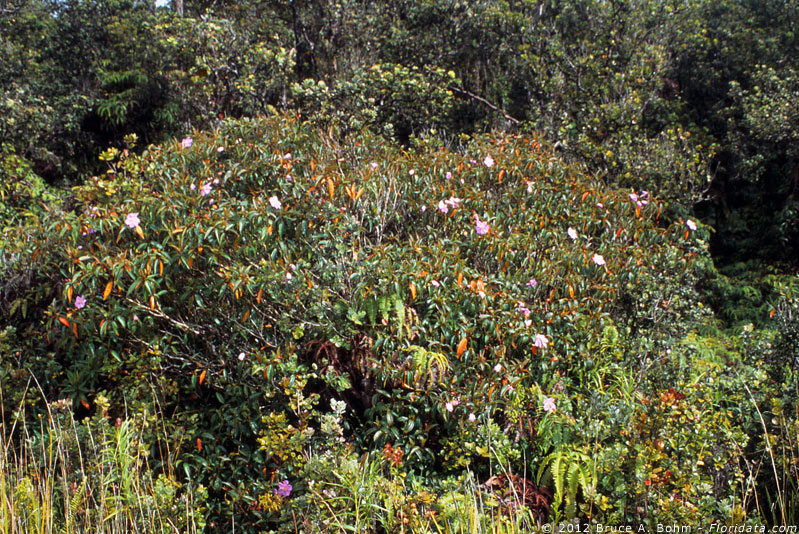
Pterolepis is a South American genus of perhaps 30 species. In the Hawaiian Islands the genus is represented by P. glomerata (see image), a weedy species that occurs in disturbed areas and beside trails. The specimen illustrated here was found growing as part of the ground cover at the picnic area on the Kuilau Trail on Kaua`i.
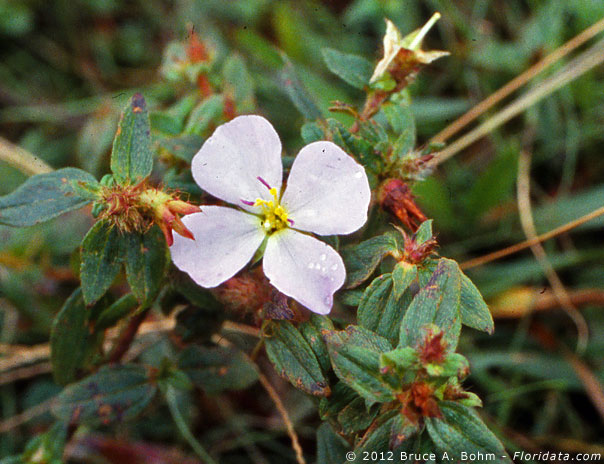
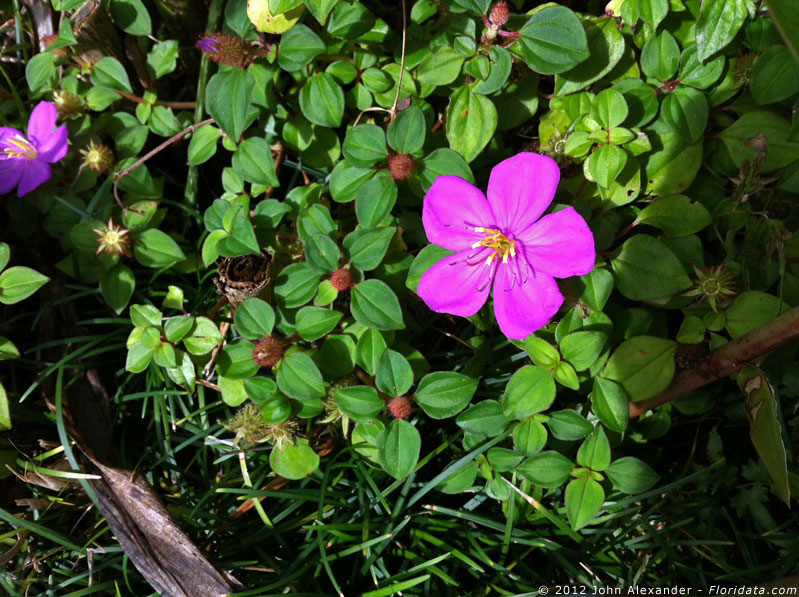
A good deal more benign than most of the above melastomes is Dissotis rotundifolia (see image) known commonly as trailing Tibouchina (see image above) among others. This plant can be found growing as a border plant along walks and driveways. This particular specimen grows in Hilo in the vicinity of the Dolphin Bay Hotel, our center of operations while working on the Big Island.
I suggested in the introduction, as others have, that a small number of invasive plant species could, if allowed to and given time, destroy all of the islands' native plants. I suggested, again in agreement with others, that the list would include miconia (Miconia calvescens) and Koster's curse (Clidemia hirta). Two other candidates that would be on my list are Myrica faya (Myricaceae), the firetree; and Passiflora moluccana (Passifloraceae), known as banana poka. We will meet both of these in this series. That makes four; what about the fifth candidate? A list of suggestions for this spot might include Schinus terebinthifolius (Anacardiaceae), the Christmas berry; Senecio madagascariensis (Asteraceae); Prosopis pallida (Fabaceae), known as mesquite; Leucaena leucocephala (Fabaceae), koa haole; Rubus argutus (Rosaceae), the Prickly Florida blackberry, and perhaps Hedychium gardnerianum (Zingiberaceae), Kahili ginger. In short, these are all bad and who makes it to the final spot on our roster of evil doers hardly matters; they all represent serious threats to the endemic flora.
Literature cited…
Burnett, K. M. 2006. Introduction of invasive species: failure of the weaker link. Agricultural and Resource Economics Review 35/1: 21-28.
Burnett, K. M., B. Kaiser, B. A. Pitafi and J. Roumasset. 2006. Prevention, eradication, and containment of invasive species: illustrations from Hawaii. Agricultural and Resource Economics Review 35/1: 63-77.
Mack, R. N. and W. M. Lonsdale. 2002. Eradicating invasive plants: Hard-won lessons for islands. In C. R. Veitch and M. N. Clout (eds.) Turning the tide: the eradication of invasive species. IUCN Invasive Specialist Group. IUCN, Gland, Switzerland and Cambridge, UK, pp. 164-172.
Meyer, J.-Y and J. Florence. 1996. Tahiti's native flora endangered by the invasion of Miconia calvescens DC (Melastomataceae). Journal of Biogeography 23: 775-781.
Ziegler, A. 2002. Hawaiian Natural History, Ecology, and Ecology. University of Hawai`i Press. Honolulu, HI.
April 22, 2012